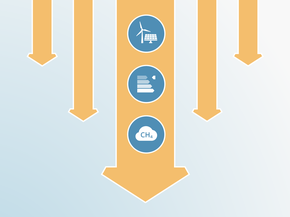Country summary
Overview
Germany’s new government took power in May 2025 under a coalition contract that undermines existing climate policies and actions. The policies described in the contract are not sufficient to meet the national climate targets as enshrined in law under the country's Climate Change Act. Yet with a 60% share of the electricity supply, expansion of renewables is still strong compared to progress in other sectors - and other countries. The CAT’s emissions projections for 2030 are now higher than the previous update. The CAT continues to rate Germany’s climate action as “Insufficient”.
Overall, Germany has a well-developed climate policy framework with legally binding climate targets, including a commitment to reach climate neutrality by 2045, and stringent national policies, which are reinforced by ambitious EU regulation. Nevertheless, the target framework is still short of being 1.5°C compatible. Germany’s new coalition government—made up of the Christian Democratic Union (CDU) and the Social Democratic Party (SPD)—is poised to deprioritise und undermine climate policy across the board. The government's coalition contract does not include additional ambitious action to achieve the 2030 emissions reductions target. Instead, the coalition agreement is largely at odds with existing emissions reductions efforts. Therefore, the new government’s approach will likely lead to higher emissions by 2030 than previously thought; a finding that the government’s own Council of Experts on Climate Change (ERK) confirmed.
Particularly concerning are the new government’s plans for the energy, transport, and buildings sectors, as well as its intention to use Article 6 carbon credits:
- Building new fossil-fuel fired power plants: the government intends to introduce 20 GW of new gas-fired power capacity by 2030; the introduction of which risks carbon lock-in and additional emissions. The proposal is a significant increase from the previous government’s plan to build 10 GW of gas-fired, hydrogen-ready gas plants. The new government has also authorised licences for new gas fields in the North Sea and wants to further subsidise gas. At the same time, there is concern the expansion of renewables, which was accelerated by the previous government, will be dampened: the new government plans to make renewable expansion conditional on grid expansion, and intends to review, and potentially reduce, the land area reserved for wind energy after 2027.
- Sending mixed signals on the decarbonisation of transport: the government is retracting the previous government’s electric vehicle (EV) sales target, while seeking to weaken the compliance rules for car companies that do not meet EU emissions performance standards. The new government planned policies generally incentivise passenger car use and ownership, including incentives for both internal combustion engine (ICE) vehicles and EVs. Subsidies for aviation are to be increased.
- Repealing the previous government’s Buildings Energy Act, which sought to phase out oil and gas in new building heating systems, rapidly scale renewables in heating, and ultimately, reach GHG-neutrality for heating by 2045: repealing the act would delay the transition to low-carbon technologies, such as heat pumps, and result in stranded assets. The EU carbon price—even if very high—will not be able to compensate for sector’s emissions because the pricing mechanism does not address investment costs, but only operational costs.
- Using international carbon credits to meet Germany’s emissions reductions targets: using Article 6 carbon credits from outside the EU is against current German and EU law and, if realised, would mark a major step backwards for German climate action and ambition. By using Article 6, the government would shift its responsibility to reduce emissions domestically and, as a result, would not contribute to increasing global emissions reductions.
A new opportunity for the government to significantly expand climate action are the newly agreed special debt-financed funds for infrastructure and climate (‘Sondervermögen’), which total EUR 500bn over the next 12 years. Of the total, EUR 100bn is explicitly earmarked for reducing greenhouse gas emissions. However, the real opportunity lies with the remaining EUR 400bn, which the government could use to further support the transition to climate neutrality or at least not hinder the transition. Doing so, however, would require significant political will and clear spending rules.
A new concern for the government is that climate change has contributed to converting German forests into a net source of emissions: they are no longer a net sink. The sector’s sink capacity was an integral part of Germany’s plan to reach ‘climate neutrality’ by 2045; residual emissions of 40 MtCO2e were expected to be compensated by a net sink of forests. If this sink is no longer available, all other sectors have to reduce to real zero so that the entire German economy can reach ‘climate neutrality’.
In the coalition contract, the new government did not to raise the ambition of Germany’s mitigation target. Not only does the government need to meet its 2030 target, the government also needs to increase the target’s ambition, which is still not 1.5˚C compatible. Current projections indicate a gap of at least 85 MtCO2e in 2030 to align emissions with a 1.5˚C compatible pathway. Given the 2023 Global Stocktake’s recognition of the need for all countries to reassess and enhance their level of climate ambition and action, Germany, through the Paris Agreement, is obliged to reinforce its 2030 ambition level. Germany, as one of the world's richest countries, has the capacity and the responsibility to pursue much more ambitious climate action.
It is also of concern that Germany is set to exceed the EU Effort Sharing Regulation’s (ESR) legally binding emissions limit, which covers emissions from transport and buildings. The failure to meet this limit must be offset by purchasing certificates. Without further action, Germany will exceed its 2030 target by at least 224 MtCO2e cumulative between 2021 and 2030, up from 126 MtCO2e estimated only a year ago. This overshoot will be expensive; for example, if certificates are each priced at EUR 100, this gap in emission reductions would cost German taxpayers EUR 22bn.
Although the new government’s coalition agreement outlines measures that will likely hinder emissions reductions, there are several ongoing positive policy developments:
- Renewables- and market-driven coal exit: the previous German government systematically removed barriers to the expansion of renewables. As a result, solar is well ahead of the government’s expansion targets. It is important to note that wind expansion is lagging behind and may be further delayed by the new government’s proposed policies. Germany phased out the last of its nuclear reactors in early 2022 and shut down a total of 16 coal-fired power plants by June 2025, while maintaining the price of electricity and the stability of the power system. Germany is set to phase out coal entirely by 2038 at the latest. If the EU ETS prices continue to increase, they will likely drive coal out of the market in Germany by 2030 due to its unprofitability.
- Contracts for difference in industry: the previous government introduced Carbon Contracts for Difference (CCfDs) to support companies in emissions-intensive industries—especially in steel, cement and chemical production—to make additional investments into zero carbon technologies. In its coalition agreement, the new government commits to continuing the programme.
In many areas, Germany still needs to make significant policy improvements to meet its climate and energy targets, and go beyond them, towards a Paris-compatible trajectory:
- Elevate climate policy to top of the agenda: the new government’s coalition contract treats climate change as a secondary issue. Proposals to expand fossil gas use do not mention the concern of increased greenhouse gas emissions.
- Focus on enabling a socially just transition: in general, climate policies are losing support across the German population because public discourse is focused on the short-term, up-front costs of climate action on private households; even though many low-carbon technologies are already cheaper than their fossil fuel counterparts over their lifecycles. To increase public acceptance of climate action, it is critical that policies are designed in a socially-just manner. This means compensating citizens for additional transition-incurred costs; the government could bring back the previously agreed upon “climate dividend,” the program by which every citizen would receive a lump sum payment from the revenue generated through the government’s carbon pricing mechanism. The government could also financially support the uptake of low-carbon technologies differentiated by income group to protect particularly vulnerable parts of the population.
You can find a German translation of this summary here.
Description of CAT ratings
The CAT rates each country’s targets and policies against (1) its fair share contribution to climate change mitigation considering a range of equity principles including responsibility, capability and equality, and (2) what is technically and economically feasible using modelled domestic pathways which, in absence of a better method, are based on global least-cost climate change mitigation.
Comparing a country’s fair share ranges and modelled domestic pathways provides insights into which governments should provide climate finance and which should receive it. Developed countries with large responsibility for historical emissions and high per-capita emissions, must not only implement ambitious climate action domestically but must also support climate action in developing countries with lower historical responsibility, capability, and lower per-capita emissions.
The CAT rates Germany’s overall climate targets, policies and finance as “Insufficient”, a rating that indicates Germany’s climate policies and commitments need substantial improvements to be consistent with the Paris Agreement’s 1.5°C temperature limit.
We rate Germany’s 2030 emissions reduction target as “Almost sufficient” when compared to modelled emissions pathways, consistent with 2°C of warming, and “Insufficient” when compared with its fair-share contribution to climate action. Germany should both further increase its emissions reduction target and provide significantly more and predictable finance to other countries to meet its fair-share contribution.
To achieve its target, Germany needs to enhance its policies and actions. It claims that it will achieve its 2030 target with current legislation, but our assessment, supported by other independent analysis, finds that it will miss it.
We rate Germany’s policies and actions until 2030 “Almost sufficient” when compared to modelled domestic pathways. We project that implemented policies and actions will lead to emissions reductions of between 61–63% below 1990 levels by 2030 excl. LULUCF. This represents a downward revision compared to last year’s estimate of 62–64% and still falls short of Germany’s 2030 target of at least 65% reduction below 1990 levels.
The newly elected German government’s climate agenda, as outlined in its coalition agreement, will likely undermine existing emission reductions efforts. The previous government, which had been in power since 2021, significantly accelerated climate policy implementation. Nevertheless, the previous government’s policies and actions were insufficient to reach the government’s climate targets. Given that the new government is weakening existing policies across all sectors, Germany’s climate targets will likely now be even further out of reach.
The new government is compromising existing emissions reductions efforts in the energy, transport, and buildings sectors by repealing existing regulation, rescinding emissions reductions targets, and building new fossil fuel-fired energy infrastructure. Further challenging emission reduction efforts is that Germany's forests are no longer a net sink of emissions but are now a net source. Its forest sink capacity was a key component of the government’s plan for reaching climate neutrality by 2045.
As a result, the 2030 target is even more difficult to achieve in comparison to our assessment in 2024. Nevertheless, the UBA claims that the cumulative emissions target from 2021 to 2030 will be achieved, but only because of overachievement in the COVID-19 pandemic. Germany's emissions level in 2030 is projected to be above the 2030 target.
The previous government weakened the Climate Change Act in May 2024, by replacing the compliance mechanism for binding sectoral emissions reductions targets with the ability for sectors to compensate for each other, as long as the overall target is met.
This conceals the fact that the transport and buildings sectors will exceed their 2030 targets. It will be almost impossible for the transport sector to catch up after 2030 unless drastic and disruptive measures are taken. Significant compensation from the other sectors will also not be possible after 2030, as it will become increasingly difficult for sectors to reduce any additional tonnes of CO2.
The full policies and action analysis can be found here.
We rate Germany’s 2030 reduction target of 65% below 1990 levels as “Almost sufficient” when compared to modelled emissions pathways. The “Almost sufficient” rating indicates that Germany’s proposed reduction target in 2030 is not yet consistent with the 1.5°C temperature limit but could be with moderate improvements, if strengthened to 70%.
If all countries were to follow Germany’s approach, warming could be held at—but not well below—2°C. While this target represents a significant improvement compared to its previous target, Germany’s new target is not stringent enough to limit warming to 1.5°C and needs further improvement.
The CAT’s assessment of Germany’s total fair share contribution takes into account its emissions reduction target and its climate finance.
We rate Germany’s 2030 target of 65% below 1990 levels excl. LULUCF as “Insufficient” when compared with its fair share emissions allocation. The “Insufficient” rating indicates that Germany’s target in 2030 and its climate finance contribution needs substantial improvements to be consistent with the 1.5°C temperature limit when compared to its fair share.
Germany should both further increase its emissions reduction target and provide significantly more and predictable finance to others to meet its fair-share contribution. Germany’s target is at the least stringent end of what would be a fair share of global effort, and is not consistent with the 1.5°C limit, unless other countries make much deeper reductions and comparably greater effort. If all countries were to follow Germany’s approach, warming would reach over 2°C and up to 3°C.
Germany’s international public climate finance contributions are better than most developed countries but still rated "Insufficient." Germany has committed to increase its climate finance, but contributions to date have been low compared to its fair share as assessed by the CAT.
To improve its rating, Germany needs to increase its international climate finance contributions in the order of factor of three, and, most urgently, stop funding fossil fuels abroad. At COP26, Germany signed a declaration to stop financing fossil fuels abroad, but later pushed to undo this decision. The CAT rates Germany’s international climate finance “Insufficient”.
Germany’s climate finance is not sufficient to improve the fair share rating, and the CAT rates Germany’s overall fair share contribution as “Insufficient”.
In June 2021, Germany adopted its 2045 net zero target in its revised Climate Change Act. The net zero target generally covers key elements but fails to meet good practice standards for some of them.
We evaluate the net zero target as: “Average.” The German government needs to legislate its commitments to include international aviation and shipping emissions and undertake planning on how to reach the 2045 target to improve its rating to “Acceptable”.
Further analysis
Latest publications
Stay informed
Subscribe to our newsletter




